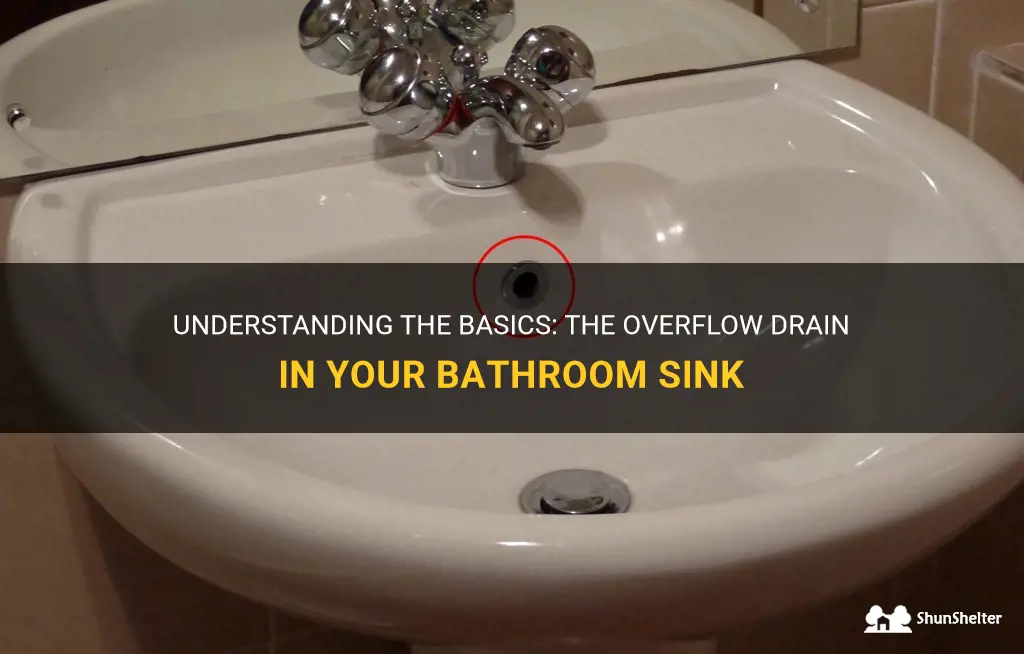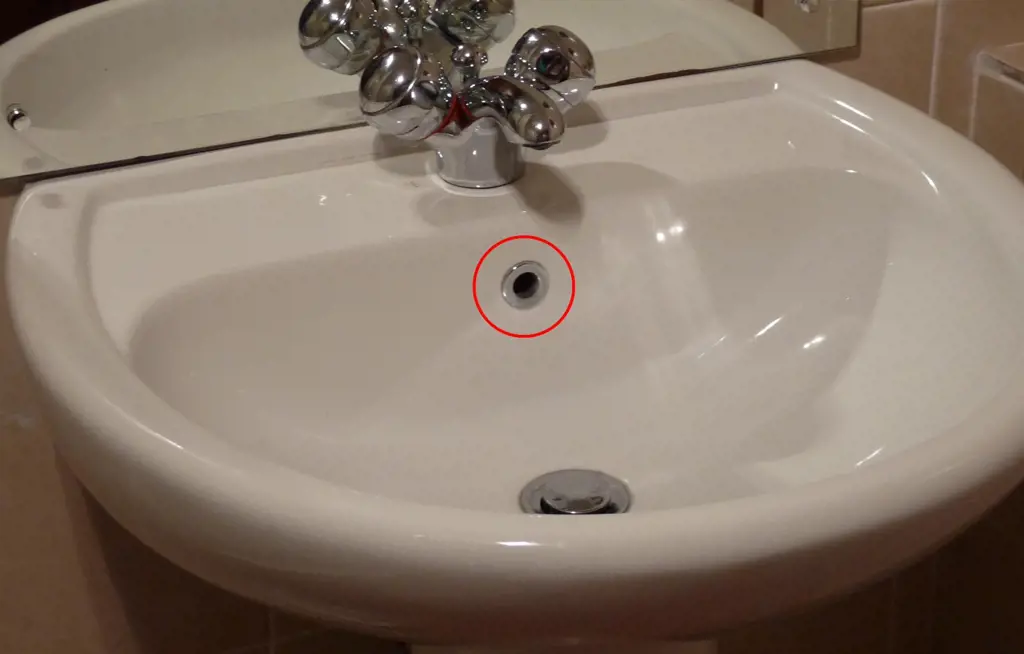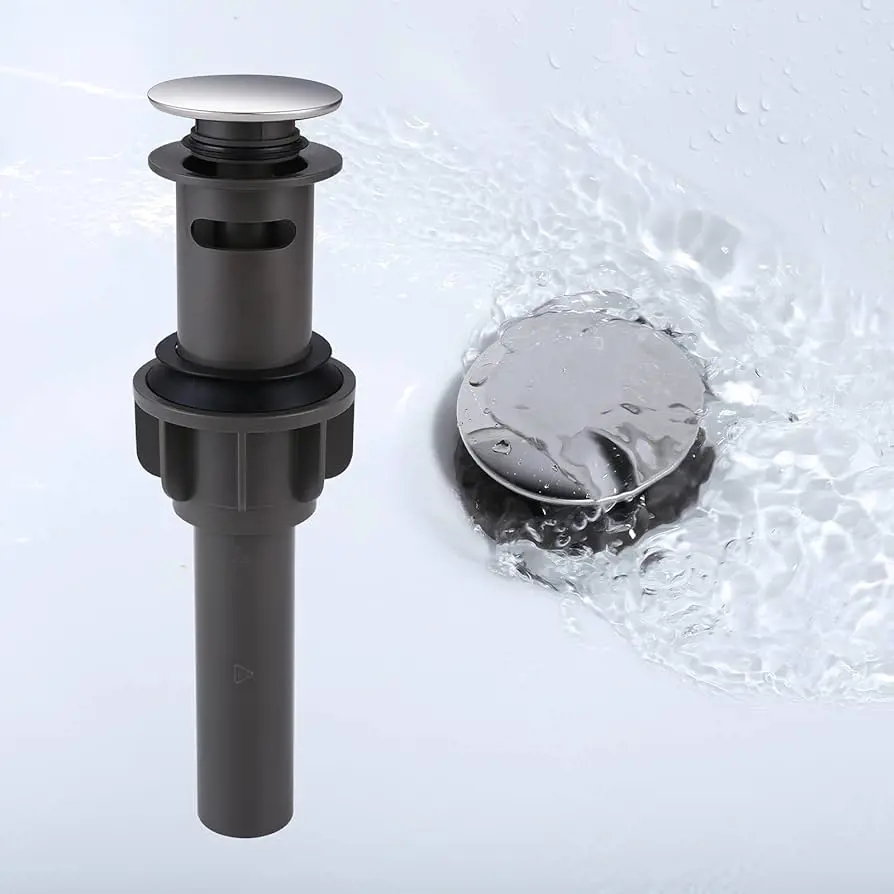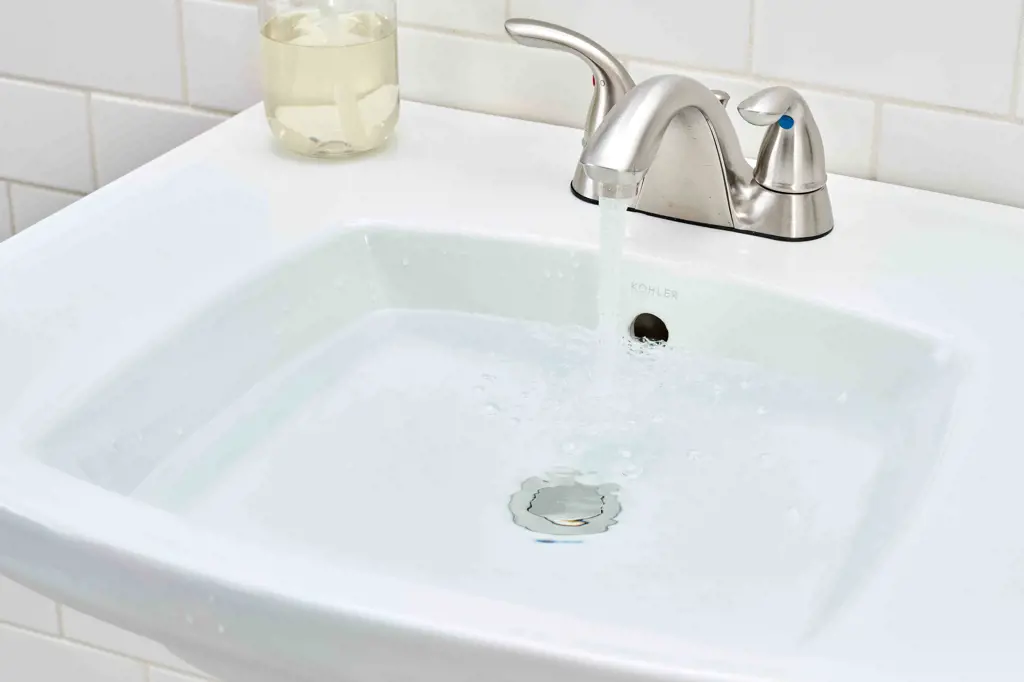
Have you ever wondered why your bathroom sink has a small hole near the top that seems to serve no purpose? This tiny opening is known as the overflow drain, a crucial component in preventing your sink from overflowing. In this article, we will explore the function and importance of the overflow drain in keeping your bathroom sink functional and maintaining a clean and safe environment.
What You'll Learn
- What is the purpose of the overflow drain in a bathroom sink?
- How does the overflow drain work in a bathroom sink?
- Can the overflow drain in a bathroom sink prevent water damage?
- Are there any specific requirements for the installation of an overflow drain in a bathroom sink?
- How can I clean and maintain the overflow drain in my bathroom sink to ensure proper functioning?

What is the purpose of the overflow drain in a bathroom sink?

Anyone who has ever used a bathroom sink has likely noticed a small opening near the top of the basin that is connected to a pipe. This opening is known as the overflow drain, and its purpose is to prevent the sink from overflowing.
The overflow drain is an important feature of a bathroom sink because it helps to prevent water damage in the event of an accidental overflow. It is especially useful in situations where the sink is left unattended, such as when someone forgets to turn off the faucet. Without an overflow drain, the sink could potentially fill up and spill over the edges, causing water to leak onto the floor and potentially causing damage to the surrounding area.
The overflow drain works by providing an alternate route for water to escape from the sink. When the water level in the sink rises above a certain point, it will begin to flow into the overflow drain and down the pipe connected to it. This effectively prevents the sink from overflowing and directs the excess water away from the basin.
The design of the overflow drain is such that it allows water to flow out, but prevents other substances from entering the pipe. This helps to prevent clogs and ensure that the overflow drain continues to function properly. Some overflow drains may also be equipped with a built-in mechanism, such as a small hole or a grille, that helps to prevent objects from accidentally blocking the drain.
To further demonstrate the purpose of the overflow drain, let's consider an example: imagine a bathroom sink without an overflow drain. If someone were to leave the faucet running and then walk away, the sink could quickly fill up and overflow onto the floor. This could lead to extensive water damage and the need for costly repairs. However, with an overflow drain in place, the excess water would simply flow into the drain and be safely redirected away from the sink.
In conclusion, the overflow drain in a bathroom sink serves an important purpose: it prevents the sink from overflowing and helps to prevent water damage. By providing an alternate route for water to escape, the overflow drain ensures that excess water is safely directed away from the sink basin. So next time you use a bathroom sink, take a moment to appreciate the small opening near the top – it's there to keep things under control.
A Guide to Finding the Right Professional to Install Your Bathroom Roof Vent
You may want to see also

How does the overflow drain work in a bathroom sink?
The overflow drain in a bathroom sink is a crucial component that helps prevent water from spilling over the edge of the sink. It is particularly useful when you accidentally leave the faucet running or when the sink is filled with water. In this article, we will explore how the overflow drain works and discuss its importance.
The purpose of an overflow drain is to redirect excess water that fills the sink to prevent it from overflowing. Whether it be due to absent-mindedness or a plumbing issue, having an overflow drain can save you from a potential mess. A bathroom sink typically has a drain opening positioned near the top of the basin, just below the rim. This opening connects to a separate pipe that leads to the main drain pipe.
So, how does the overflow drain work?
- Water flows into the sink: When you turn on the faucet, water flows into the sink basin and starts to fill up.
- Water reaches the maximum level: As the water level rises, it eventually reaches the overflow drain opening. At this point, water starts to flow into the overflow drain instead of spilling over the edge of the sink.
- Water enters the overflow pipe: The overflow drain opening is connected to a pipe that runs parallel to the main drain pipe. The excess water flowing through the overflow drain enters this pipe and is directed towards the main drain pipe.
- Water exits through the main drain pipe: The overflow pipe is connected to the main drain pipe further down the plumbing system. The excess water flows through the main drain pipe and is ultimately carried out of the building's plumbing system.
The overflow drain serves as a safety measure to prevent water damage and flooding. Without the overflow drain, if the sink were filling up unattended, the water would overflow and potentially cause damage to the surrounding area. Additionally, if the sink is filled with a large amount of water, such as when soaking clothes or cleaning items, the overflow drain ensures that the water level remains controlled.
In some cases, the overflow drain may also be designed to serve as a vent. It allows air to flow into the plumbing system, preventing a vacuum from forming and helping sewage and wastewater flow smoothly through the drains. The venting function of the overflow drain is particularly important in multi-story buildings as it enables efficient drainage throughout the entire plumbing system.
To summarize, the overflow drain in a bathroom sink acts as a safety feature to prevent water from overflowing and causing potential damage. It works by redirecting excess water through a separate pipe that leads to the main drain pipe. The design of the overflow drain also facilitates venting, ensuring proper drainage throughout the plumbing system. Next time you use your bathroom sink, take a moment to appreciate the functionality and importance of the overflow drain.
Making the Most of Limited Space: How to Bathe with only a Bathroom Sink
You may want to see also

Can the overflow drain in a bathroom sink prevent water damage?
The overflow drain in a bathroom sink is a small hole located near the top of the sink basin. Its purpose is to prevent water from overflowing onto the floor or countertops in case the sink gets filled up. This can happen when the drain is clogged or the faucet is left running.
Water damage can be costly and difficult to fix, so it is important to have preventive measures in place. The overflow drain is one of those measures. It acts as a safety net, allowing excess water to drain out of the sink instead of overflowing.
From a scientific perspective, the overflow drain works based on the principle of air pressure. When the water level in the sink rises above the level of the overflow drain, air is pushed out of the drain, allowing the water to flow out. This prevents the water from rising any further and causing damage.
In terms of experience, many people have probably encountered situations where the overflow drain has saved them from water damage. Imagine leaving the faucet running and coming back to find the sink overflowing. Without the overflow drain, you would be left with a big mess to clean up. However, thanks to the drain, the excess water drains out, preventing any damage.
To understand how the overflow drain works step-by-step, let's consider the following scenario:
- The sink starts to fill up due to a clogged drain or a running faucet.
- As the water level rises, it eventually reaches the level of the overflow drain.
- The excess water flows into the overflow drain, creating a pressure differential.
- The air in the drain is pushed out, allowing the water to flow out.
- Once the water level drops below the level of the overflow drain, the flow stops.
This simple mechanism effectively prevents water damage by providing an alternative route for the water to escape. It is a small feature that can make a big difference in protecting your bathroom from water-related issues.
In conclusion, the overflow drain in a bathroom sink is a crucial component in preventing water damage. It works based on the principles of air pressure and provides a safe outlet for excess water to drain out. Whether it's a clogged drain or a running faucet, the overflow drain acts as a safety net, saving you from potential water damage. So, the next time you notice water rising in your sink, be grateful for the overflow drain and its important role in protecting your bathroom.
Exploring the Popularity of Dual Sink Bathrooms
You may want to see also

Are there any specific requirements for the installation of an overflow drain in a bathroom sink?

When it comes to installing an overflow drain in a bathroom sink, there are a few specific requirements that need to be met. The purpose of an overflow drain is to prevent water from overflowing and causing damage to the sink or surrounding area. In this article, we will discuss the steps involved in installing an overflow drain and the requirements that need to be considered.
- Determine the location: The first step in installing an overflow drain is to determine the location where it will be placed. Ideally, the overflow drain should be positioned above the maximum water level in the sink. This will ensure that it effectively prevents overflowing.
- Choose the drain assembly: There are various types of overflow drain assemblies available in the market. You need to choose one that is compatible with your sink and meets your requirements. Make sure to measure the sink's drain hole to ensure a proper fit.
- Install the drain assembly: Once you have chosen the drain assembly, you can proceed with the installation process. Start by removing the existing drain stopper from the sink. Then, insert the overflow drain assembly into the drain hole. Make sure it is properly aligned and fits snugly.
- Connect the plumbing: After installing the overflow drain assembly, you will need to connect it to the plumbing system. This typically involves attaching the drain pipe to the assembly using a wrench or pliers. Make sure to tighten the connections properly to prevent any leaks.
- Test for leaks: Once the overflow drain is installed and connected to the plumbing system, it is essential to test for leaks. Fill the sink with water up to the overflow level and observe if any water leaks from the drain assembly. If there are any leaks, tighten the connections further or consult a professional plumber for assistance.
Additionally, there are a few other factors to consider when installing an overflow drain in a bathroom sink:
- Sink material: The material of the sink can affect the installation process. For example, if you have a porcelain sink, you may need to use a specialized drill bit to create the drain hole without damaging the surface.
- Local plumbing codes: It is important to check your local plumbing codes before installing an overflow drain. Some areas may have specific regulations regarding the installation of overflow drains, such as the minimum distance between the drain and the sink's rim.
- Maintenance: Once the overflow drain is installed, it is essential to regularly clean and maintain it to ensure its proper functioning. This can involve removing any debris or blockages that may accumulate over time.
In conclusion, installing an overflow drain in a bathroom sink requires careful consideration and adherence to specific requirements. By following the steps mentioned above and considering factors like sink material and local plumbing codes, you can ensure a successful installation and a well-functioning overflow drain.
The Ultimate Guide to Maintaining a Clean Bathroom or Toilet
You may want to see also

How can I clean and maintain the overflow drain in my bathroom sink to ensure proper functioning?

The overflow drain in a bathroom sink is an important component that prevents water from overflowing and causing damage to the surrounding area. However, over time, this drain can get clogged and reduce its effectiveness. Cleaning and maintaining the overflow drain is essential to ensure it continues to function properly. In this article, we will discuss some methods to clean and maintain the overflow drain in your bathroom sink.
Before we begin, it's important to note that these methods can be applied to most types of bathroom sinks, including ceramic, porcelain, and stainless steel sinks.
Step 1: Gather the necessary tools and materials. You will need a pair of rubber gloves, a wire hanger or a drain snake, a bucket, baking soda, vinegar, and a cleaning brush or toothbrush.
Step 2: Start by removing any objects or debris that may be blocking the overflow drain. Take off the sink stopper and use a pair of rubber gloves to reach into the drain and remove any visible items such as hair, soap residue, or small objects.
Step 3: If the overflow drain is still clogged, try using a wire hanger or a drain snake to clear the blockage. Straighten the wire hanger or insert the drain snake into the overflow drain and gently push it down. Rotate the hanger or drain snake to dislodge any debris that may be causing the clog. Pull out the wire hanger or drain snake and remove any debris that comes out with it.
Step 4: Mix equal parts of baking soda and vinegar to create a natural cleaning solution. Pour the mixture down the overflow drain and let it sit for about 15 minutes. The combination of baking soda and vinegar will help dissolve any soap scum, grease, or other buildup in the drain.
Step 5: After the baking soda and vinegar mixture has had time to work, use a cleaning brush or toothbrush to scrub the inside of the overflow drain. Be sure to reach all areas of the drain, including the sides and bottom. Rinse the drain with hot water to flush out any remaining residue.
Step 6: Repeat the cleaning process regularly to prevent future clogs in the overflow drain. We recommend cleaning the overflow drain at least once a month or more frequently if you notice a buildup of debris or slow draining in your sink.
By following these steps and regularly cleaning and maintaining the overflow drain in your bathroom sink, you can ensure its proper functioning and prevent any potential water damage. Remember to always wear gloves when dealing with drain cleaning products and tools and consult a professional plumber if you encounter persistent or severe clogs.
The Surprising Answer to How Many Bathrooms a Well Can Supply
You may want to see also
Frequently asked questions
The overflow drain in a bathroom sink is a small opening located near the top of the sink bowl, typically towards the back. Its purpose is to prevent the sink from overflowing by diverting excess water into the drain pipe.
When water reaches a certain level in the sink bowl, it starts to flow into the overflow drain. The overflow drain is connected to the same drain pipe that the regular sink drain is connected to, allowing the excess water to flow out and preventing overflow.
An overflow drain is important because it helps prevent water damage and flooding in the bathroom. If the sink were to overflow, it could cause water to spill out onto the countertop and potentially damage the surrounding area. The overflow drain prevents this by providing a secondary outlet for excess water to escape.







